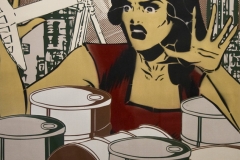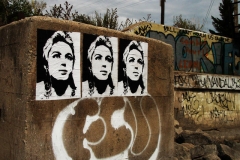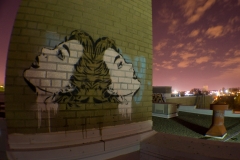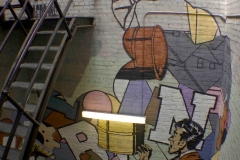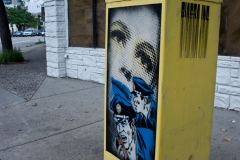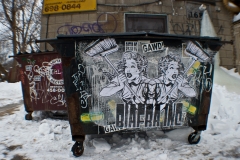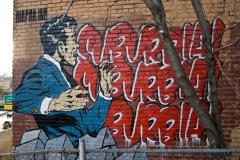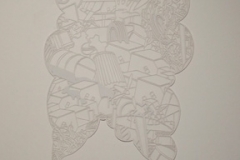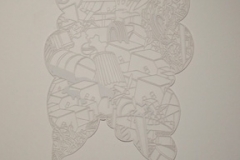An Interview with Biafra, Inc.
 by Benjamin Davis Brockman
by Benjamin Davis Brockman
August 1, 2012
For years before he was Biafra Inc., the mysterious Minneapolis street artist was cutting stencils and creating logos. Like a lot of young artists, skateboarding and punk rock were chief influences leading to his interest in art as a powerful social tool. In 2007, he adopted his trademark of Biafra Inc.—a name which carries tremendous cultural significance, not only as the assumed surname of Dead Kennedy’s frontman (and leading figure of the Green Party) Jello Biafra, but also the plight of the people of the Nigerian secessionist state in the late 60’s, which led to a bloody civil war surrounding economic, ethnic and religious tension.
Biafra Inc.’s name plays with the weight of two polemic socio-political issues, which are overt in his graphic street works, often illustrating ideas of capitalistic turmoil in aesthetics matching those of freshly printed Dick Tracy comic strips. His socially reflexive graphic images are so polished it is hard to refer to them as graffiti. Biafra has also distributed as many as 55,000 free stickers in just a few years, the designs of which are constantly being re-invented, making it nearly impossible to traverse any Minneapolis thoroughfare without reading the name. His trademark is expanding exponentially, but if you don’t happen to notice the logo at first glance, keep an eye out. Biafra has a keen sense for subtly integrating his presence in the urban landscape. He has said of the longevity of some of his tags: “If you can make a sticker look like it’s supposed to be there, it can run a lot longer.” But tagging clearly isn’t necessarily the M.O. of this particular street artist. As he dots the streets with sections of an ever-growing graphic novel, he also creates reflexively public works that address social issues related to media and commercialism through iconic figures or “storytellers,” which represent the omens and portents of our time.
The Fiddleback: Your art and street work seem to share a street art aesthetic. What is the relationship between your studio practice and what you do at large? Does one inform the other? Are those practices exclusive of each other in anyway?
Biafra Inc.: Oh yeah, they definitely inform one another. I started with street art before I ever got into fine art, so I think it was sort of natural to carry that aesthetic over. Now that I’m doing both, there’s still a very strong relationship. I may do something on the street and like the way it looks after sitting in that environment for a while—like the way someone attempted to get a poster or sticker off or the way the dirt flew up on it and try to capture that feeling in my future work.
The Fiddleback: How do you see the relationship between fine art and street art? What are the differences for the artist, as well as the audience?
BI: For me the streets are a great way to experiment with what works and [what] doesn’t work. I think it’s much more free than my studio practice which is more planned out. As far as the audience it’s obviously much more broad than people who just go to galleries it’s anyone passing by. It’s nice to hear someone say that they walked by your piece everyday on the way to work and it gave them something else to think about.
The Fiddleback: What effect has the phenomenon of Exit Through the Gift Shop had on the culture and aesthetics of street art?
BI: In all honesty, I think it killed it. It was a funny movie and enjoyable to watch, but I think it gave people the idea that street art was something they could get into to make it big quickly. It’s also frustrating because when I’m out doing a mural it’s almost a guarantee that everyday I’m there someone will ask, “Oh, have you seen that movie from that guy Banksy? Enter through the front door? Do you know him? He’s great don’t you think?” And that’s pretty much the end of that interaction. It’s tough to have people have only a surface value view of what you do, it was better when people had no idea about it.
The Fiddleback: Who do you think of as being your influences? What are the social phenomena that you dwell on in generating imagery?
BI: I’d say I’m influenced a lot by the news. I love the news: the stories, the struggle and resolution. I think my work reflects that. I’m also very interested in the pulp era of literature and comics, particularly during the Great Depression where people read them as an escape from their crappy surroundings. I like taking these characters meant for escape and giving them no hope, getting engulfed in problems.
The Fiddleback: What artists inspire your work? Is there anyone working right now that gets you particularly excited?
BI: I’m generally inspired by anyone that is prolific, especially King Mini. I like his use of color and halftone to create depth. I really like his ability to produce too. He’s always got something in the works. I’m inspired by comics and graphic novels. I really like Craig Thompson and Will Eisner.
I think it’s important because [street art] puts art back in the hands of the people. If you like a poster you can take it (provided you can get it off). If you hate something you can tear it down. It’s total freedom. It’s installation at its purist form—pieces reacting to the environment and creating conversation with it.
The Fiddleback: What is it about the sticker that you think so many people gravitate towards? Do stickers say something specific?
BI: I think people gravitate towards it because it’s something with which they’re already familiar. Kids start using stickers at a very young age, adding them into drawings, putting them on their toy box or on themselves. I think you just grow up with stickers. For me personally, I’ve always enjoyed getting stickers with purchases or when I was younger getting a sticker on a test, stuff like that. Putting a sticker on something is instantly gratifying and very fast. They don’t have the stigma that spray paint and markers do.
The Fiddleback: Can you think of an answer to the question that Shepard Fairey asks: “Why is noncommercial public expression considered criminal?” Do you think this will change? If it weren’t criminal, would the practice itself become more or less important?
BI: I think its fear of not understanding. I think people tend to react better to things that are simple where there is a transaction handing over money for the use of a space. I think it’s hard for people to understand why someone would use their own time, freedom and money to put up something that isn’t selling something. And as it turns out, someone in all black hanging off a fire escape also looks suspiciously like a burglar, so I think people get afraid you’re breaking in or something. I think people are starting to get it, but I don’t think they ever will completely. As far as the legality, I think it would make it completely meaningless if it were to become legal. I think it’s better to have someone who desperately wants to go out and put their stuff up knowing there are risks and losses, but that’s the how badly they want to give their work to the public. To me, breaking the law is part of what you admire about street art. It’s part of the craft.
The Fiddleback: Speaking of Fairey, what is your opinion of the OBEY phenomenon? The line between commercial art, fine art, and street art seems to be getting blurrier and blurrier. What is the role of the original print—or even the original artwork in all of this?
BI: I think OBEY is great in terms of getting issues out to people. I think he does a good job of using his platform to help others. However, I think he has also taken tremendous advantage of what he started on the streets. Now when you see an OBEY sticker or a poster, the first thought is no longer the movement; it’s about that cool shirt you saw at Urban Outfitters or The Buckle. The message has been lost in the quest for the almighty dollar. His work has become an ad for all of his other business ventures. I think that’s the case with a number of people. The blurring of that line makes it confusing because suddenly you see this artist you like on a box for a company that goes against what they’re saying. I’m not saying working for people is bad, but I think you need to make sure you believe in what the company is doing because they, whether you like it or not, are now representing you and vice-versa.
In this world of blurred lines I think the original becomes a stand in for purity or at least it should. The original is art that is critiqued to strengthen content rather than sales. It’s art unconcerned with buyers. It’s about problem solving and creating a feeling that you don’t get from looking at a cool Kleenex box.
The Fiddleback: Why do you think this art form is important?
BI: I think it’s important because it puts art back in the hands of the people. If you like a poster you can take it (provided you can get it off). If you hate something you can tear it down. It’s total freedom. It’s installation at its purist form—pieces reacting to the environment and creating conversation with it.
The Fiddleback: What would you say to a young person or anyone aspiring to a life as an artist?
BI: Work hard every day. There’s a feeling going around that my generation and the ones younger are entitled, snotty lazy people expecting to get stuff handed to them. Sadly, there are a lot of kids like that I’ve met, but the sooner you realize that’s not going to get you anywhere the better. You have to be dedicated, believe in yourself and take criticism. All work has flaws, the fewer the better. And get involved in a group of people with similar interests. Community is really important. Having people to bounce ideas off of and work with can be super helpful.
——–
Biafra, Inc.
